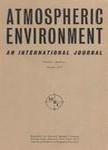版权所有:内蒙古大学图书馆 技术提供:维普资讯• 智图
内蒙古自治区呼和浩特市赛罕区大学西街235号 邮编: 010021

作者机构:Phys Res Lab Space & Atmospher Sci Div Ahmadabad 380009 Gujarat India Ctr Dev Adv Comp Computat Earth Sci Grp Pune 411007 Maharashtra India
出 版 物:《ATMOSPHERIC ENVIRONMENT》 (大气环境)
年 卷 期:2015年第116卷
页 面:225-244页
核心收录:
学科分类:0830[工学-环境科学与工程(可授工学、理学、农学学位)] 08[工学] 0706[理学-大气科学]
基 金:ISRO-GBP ISRO Headquarters Bengaluru
主 题:Aerosols India Observations Models Aerosol optical depth Single scattering albedo Absorbing aerosol optical depth
摘 要:An analysis of aerosol characteristics measured using sun photometers, MODIS and MISR, and simulated using global aerosol models (GOCART and MOZART) over six distinctly different environments in India reveal significant regional and temporal variations. Model AODs are lower than measured AODs, and exhibit a winter low and summer high, while features in measured AODs differ. MODIS and MISR AODs are higher than model simulated AODs. Differences between measured and model AODs arise due to absence of seasonal cycle in model AODs which occurs mainly due to lack of proper representation of aerosol emissions and not due to meteolorogy. In model simulations dust (40% during premonsoon) and sulfate (40% during monsoon) contribute the maximum to total AOD. Model derived single scattering albedo (SSA) is higher than measured SSA over the study locations because simulated BC is low. The inter-annual variability in model derived SSA is lower than model-observation differences in SSA. The intra-regional variation in model AODs is lower than that of MODIS AODs. Sea salt contributes similar to 10% to total AOD during monsoon only over Peninsular and west Central India. The underestimation of AODs by GOCART and MOZART and space-time differences with observations strongly favors improving the emission inventories of aerosol sources and removal mechanisms of aerosols in the models. Results from present study can serve as inputs to tune models because not only total AODs but also species AODs, and their amount need to be properly simulated in order to reduce the uncertainty in radiative and climate impact of aerosols. (C) 2015 Elsevier Ltd. All rights reserved.